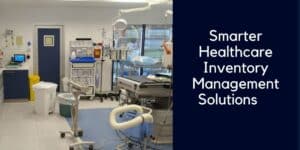The combination of high-value medical supply in operating rooms (OR) and the growing popularity of the consignment selling model creates new challenges for the OR staff and their suppliers alike. Efficient management of such high-value inventory is the key for cost reduction, improved operational efficiency and streamlined communication between suppliers and OR staff.
Operating Room Challenges With High Value Inventory
| Improving logistic processes can contribute to OR efficiency | The shift to consignment reduced most of the direct costs derived from owning high-value medical supplies but created new challenges in the supply chain that the OR staff doesn’t necessarily have the right tools to deal with, resulting in reduced efficiency of the OR. Medical staff is now required to maintain inventory levels, initiate procurement processes, properly store and use, while having increased interaction with the suppliers. | |
| Inventory Management Challenges | ||
| High value medical devices impose challenges in any selling model | When owned by the hospitals, high-value medical supplies bought in bulks, creating a logistic problem to properly store and account. Any misplaced or lost item is direct loose and expired items may jeopardize patient’s safety.
Consigned items are just as hard to manage – only few items from each medical product are stored in the OR (mostly only 1), making the daily inventory control a curtail process in the daily activities and forcing the OR staff to devote their precious time to logistic procedures rather than medical ones. |
|
| OR Procedures | ||
| Overworked staff and lack of information prevents proper patient billing | Hospital accounting and patient billing depend on proper reporting in the OR regarding the procedures that took place and supplies used. Since consigned inventory is managed outside of the hospital’s ERP, this essential reporting is likely to be overlooked due to staff’s workload and personnel shortage. | |
| Suppliers Challenges | ||
| Suppliers of high-value medical devices face tremendous challenges when providing their products to the hospitals in consignment terms, and are required to remotely manage an inventory worth millions of dollars while distributed across dozens different sites, resulting in high looses, growing operational expenses and reduce labor efficiency. | ||
| Inventory Management Challenges | ||
| Consignment model reflect high operational costs | Supplier finds that the only way to maintain control of their distributed high-value inventory is through excessive labor, repeatedly cycling between the sites to count the stock. On top of the high operational costs this situation implies, the information gathered is exposed to human errors. Although there should be no more than 1 or 2 items from each catalogue number in every OR, supplier compensate for the lack of visibility by increasing their stock in the OR, resulting in inefficiency and even greater inventory management challenges.
|
|
| Billing and communication with hospitals | ||
| Suppliers dependency in OR reports of consumed items, so they can invoice them, sets the ground for disagreements and lack of trust. Misplaced and lost items reflect a problem too, with both sides having to discuss and resolve these issues on a monthly basis, striving to maintain the mutual trust. | ||
|
|
||
| The solution: Remote inventory management | ||
| Remote inventory management system increase OR efficiency and profits | Remote Inventory management systems can help both hospitals and suppliers to overcome the challenges they face, improve their efficiency and increase their profits.By placing the OR’s high-value medical supplies in a storage system that can automatically detect and report its content, all parties can review inventory information and analyze it according to their needs.
The above chart shows the compounded efficiency in an Israeli operating room, and the improvement achieved when implementing Remote High Value Inventory Management systems (RIVMAS). Lost and misplaced supplies were down to less than 1%, while revenue capture raised by 15%. Time devoted by OR staff to logistic procedures was reduced by 78%’, and overall weighted OR efficiency raised by 23%. |
|
| Improved Hospital Processes | ||
| Inventory management system can improve and automate hospital logistic procedures | As soon as their high-value inventory is stored in smart storage systems, hospitals can utilize the information generated by it to improve their efficiency by tracing each item, maintaining stock levels and reducing the overhead involved in manual stocktaking. As a consequence, the OR staff will be able to devote their time to medical procedure and patient caring, instead of time consuming logistic ones.Supply chain automation – Hospitals can integrate the solution with their ERP to enable automatic replenishment upon consumption, thus implementing further automation in their supply-chain.
Increased revenue capture – By integrating the remote high-value inventory management with their Hospital Information Systems (HIS), hospitals gain the ability to accurately track the supplies consumed during surgeries, bill patients accordingly and improve their revenue capture. Increased satisfaction – By eliminating supply management procedures, OR staff can devote their time to medical procedures and patient care, leading to an increase in their job satisfaction and overall productivity. |
| Suppliers Benefits | |
| Remote inventory management system is the supplier eyes in the OR, and enables higher revenue capture and substantial cost reduction | A Remote High-Value Inventory Management Systems provides suppliers of medical devices and item-level tractability and supply chain visibility that otherwise could not be achieved. Increased efficiency – By remotely managing and controlling their consigned stock, suppliers can reduce their inventory in every OR by as much as 30%.
Reduced costs – Once suppliers no longer need to send personnel for manual stocktaking. Their operational procedures are optimized, and labor costs are reduced. Improved revenue capture – Suppliers gain access to near real-time information regarding item consumption, enabling them to invoice hospitals accordingly and improve their revenue capture. Improved relation with hospitals – By working with a mutual information system, hospital accounting and communication performed based on shared information, reducing chances for arguments and improving their satisfaction as customers.
|








